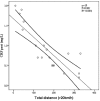Relationship of Pre-season Training Load With In-Season Biochemical Markers, Injuries and Performance in Professional Soccer Players
- PMID: 31031638
- PMCID: PMC6474299
- DOI: 10.3389/fphys.2019.00409
Relationship of Pre-season Training Load With In-Season Biochemical Markers, Injuries and Performance in Professional Soccer Players
Abstract
Introduction: There is controversy in the literature in regards of the link between training load and injury rate. Thus, the aims of this non-interventional study were to evaluate relationships between pre-season training load with biochemical markers, injury incidence and performance during the first month of the competitive period in professional soccer players.
Materials and methods: Healthy professional soccer players were enrolled in this study over two pre-season periods. Data sets were available from 26 players during the first season (2014-2015) and 24 players during the second season (2015-2016) who completed two pre-season periods (6 weeks each). External training load was assessed from all athletes during training using Global Positioning System (GPS). Internal training load was monitored after each training session using rate of perceived exertion (RPE). Before and after each pre-season, blood samples were taken to determine plasma lactate dehydrogenase (LDH), creatine kinase (CK) and C-reactive protein (CRP). Injury incidence and overall performance (ranking of the team after the first five official games of the championship) were recorded for both seasons separately.
Results: There was no statistically significant difference in mean RPE values of the two-preparation periods (2737 ± 452 and 2629 ± 786 AU, p = 0.492). The correlational analysis did not reveal significant associations between internal and external training load (RPE and GPS data) and biological markers. There was a significant positive correlation between RPE and LDH during the 2015/2016 season (r = 0.974, p = 0.001). In addition, a significant negative correlation was found between total distance >20 km/h and CRP during the 2015-2016 season (r = -0.863, p = 0.027). The injury rates for the two seasons were 1.76 and 1.06 per 1000 h exposure for the 2014-2015 and 2015-2016 seasons, respectively (p = 0.127).
Conclusion: Our study showed that pre-season training load is not associated with overall team performance. This association is most likely multifactorial and other factors (e.g., technical and tactical level of the team, opponents, environment) may play an important role for the collective team performance. Our findings may help coaches to better prepare their athletes during pre-season.
Keywords: blood sample; elite athletes; football; global positioning system; monitoring.
Figures
Similar articles
-
Internal and External Training Load in Under-19 versus Professional Soccer Players during the In-Season Period.Int J Environ Res Public Health. 2021 Jan 11;18(2):558. doi: 10.3390/ijerph18020558. Int J Environ Res Public Health. 2021. PMID: 33440830 Free PMC article.
-
In-season training load quantification of one-, two- and three-game week schedules in a top European professional soccer team.Physiol Behav. 2019 Mar 15;201:146-156. doi: 10.1016/j.physbeh.2018.11.036. Epub 2018 Dec 6. Physiol Behav. 2019. PMID: 30529511
-
Wellbeing perception and the impact on external training output among elite soccer players.J Sci Med Sport. 2018 Jan;21(1):29-34. doi: 10.1016/j.jsams.2017.03.019. Epub 2017 Apr 13. J Sci Med Sport. 2018. PMID: 28442275
-
Training in women soccer players: A systematic review on training load monitoring.Front Psychol. 2022 Jul 29;13:943857. doi: 10.3389/fpsyg.2022.943857. eCollection 2022. Front Psychol. 2022. PMID: 35967662 Free PMC article.
-
Relationship between Training Load Management and Immunoglobulin A to Avoid Immunosuppression after Soccer Training and Competition: A Theoretical Framework Based on COVID-19 for Athletes' Healthcare.Healthcare (Basel). 2021 Jul 6;9(7):856. doi: 10.3390/healthcare9070856. Healthcare (Basel). 2021. PMID: 34356234 Free PMC article. Review.
Cited by
-
The Association of Serum Calprotectin with Fitness Indicators and Biochemical Markers in High-Level Athletes: A Continuous Dynamic Monitoring during One Competitive Season.Sports (Basel). 2023 Dec 14;11(12):243. doi: 10.3390/sports11120243. Sports (Basel). 2023. PMID: 38133110 Free PMC article.
-
Seasonal Changes and Relationships in Training Loads, Neuromuscular Performance, and Recovery and Stress State in Competitive Female Soccer Players.Front Sports Act Living. 2021 Oct 11;3:757253. doi: 10.3389/fspor.2021.757253. eCollection 2021. Front Sports Act Living. 2021. PMID: 34708201 Free PMC article.
-
Effects of a Preseason Neuromuscular Training Program vs. an Endurance-Dominated Program on Physical Fitness and Injury Prevention in Female Soccer Players.Sports Med Open. 2024 Jun 26;10(1):76. doi: 10.1186/s40798-024-00731-7. Sports Med Open. 2024. PMID: 38922502 Free PMC article.
-
Biomarkers of post-match recovery in semi-professional and professional football (soccer).Front Physiol. 2023 Apr 11;14:1167449. doi: 10.3389/fphys.2023.1167449. eCollection 2023. Front Physiol. 2023. PMID: 37113691 Free PMC article. Review.
-
Internal and External Training Load in Under-19 versus Professional Soccer Players during the In-Season Period.Int J Environ Res Public Health. 2021 Jan 11;18(2):558. doi: 10.3390/ijerph18020558. Int J Environ Res Public Health. 2021. PMID: 33440830 Free PMC article.
References
-
- Carling C., Williams A. M., Reilly T. P. (2005). The Handbook of Soccer Match Analysis: A Systematic Approach to Performance Enhancement. Abingdon: Routledge.
LinkOut - more resources
Full Text Sources
Research Materials
Miscellaneous



